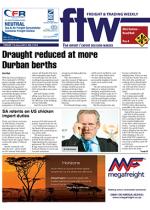This week saw the launch of a
Cairo-to-Cape Town free trade
area (FTA) that’s bigger than
the European Union (EU).
This Tripartite Free Trade
Area (TFTA) spans 26 nations
in Africa, with a population
north of 600 million, and was
signed off on June 10 in Egypt.
Although much of West
Africa isn’t covered, the deal
means a huge stripe of southern
and eastern Africa will be. And,
according to the Brookings
Institute, this will cover 58% of
Africa’s economic activity and
over R12 trillion in
gross domestic
product (GDP).
And the
creation of
this trade bloc
is a positive
step towards
improved
investment flow and the
facilitation and flow of goods
in the region, Jonathan Horn,
MD of Maersk Line Southern
Africa, told FTW.
“This FTA,” he added,
“will promote active trade
between SA and the rest of the
continent.
“It will allow the
enhancement of trade
facilitation and improve the
flow of goods in the region
by reducing bureaucratic
complexity, lowering transit
times and the cost of trading.”
But a fully up-and-running
TFTA is not going to occur
overnight, according
to Duncan Bonnett,
partner of trade consultancy,
Liz Whitehouse & Associates,
and an African trade specialist.
“It’s still a long way off,” he
said.
However, he added, now is
the time for SA companies to
start taking a good look at the
opportunities stemming from
this FTA.
“They need to look at it
more holistically,” Bonnett told
FTW, “and at how they can
leverage the preferential trade
agreements.”
And he saw the main
benefit for SA trade being
greater access to the East
African Community (EAC)
– a five-nation
geographical
region covering an
area of 1.8 million
square kilometres,
with a combined
population of
about 150m and
a combined gross
domestic product
of over R3.6tn.
“In the import
basket in the EAC you’ll see big
supplies from the Middle East
and China,” said Bonnett. “And,
if we get tariff preferences of say
10%-15%, we’ll be that much
more cost-competitive.
“From an SA import point of
view, the same reduced import
duties into this country would
hopefully encourage local
companies to import more
from the EAC, such as coffee
and tea, rather than importing
from South America and
South-East Asia.”
Another promising event
Bonnett highlighted was
Ethiopia’s accession to the
World Trade Organisation
(WTO). This will increase that
country’s trade volume due
to the tariff reduction, also
providing for a transparent
and predictable regulatory
framework, and prohibiting
arbitrary and discriminatory
restrictions on foreign trade.
“It’s a country with a
population of 90m (second
biggest in Africa after
Nigeria) and needs lots of
imports,” he said.
Horn however pointed
out that although the region
offered so much potential,
intra-African trade links
remained weak. According to
research conducted by Ecobank
only 12% of regional trade is
conducted with other African
countries. This is in comparison
to Europe where 60% of trade
is conducted with its own
continent.
“This highlights the
opportunity to improve trade
between SA and the rest of
Africa, as well as how local
companies can stand to benefit
from exploring the region,”
Horn added.
“The TFTA will reduce risks
associated with trade in the
region and essentially make
Africa an easier place to do
business – an opportunity that
SA companies should explore.”
INSERT & CAPTION 1
The main benefit for
SA trade is greater
access to the EAC.
– Duncan Bonnett
INSERT & CAPTION 2
The FTA will reduce
bureaucratic
complexity, lowering
transit times and the
cost of trading.
– Jonathan Horn

